An international research team used the Atacama Large Millimeter/submillimeter Array (ALMA) to observe the triple protostar system IRAS 04239+2436, to investigate the detailed structure of the gas around the protostars.
As a result, the scientists, led by Jeong-Eun Lee, a professor at Seoul National University, detected radio waves emitted by sulfur monoxide (SO) molecules that indicate the presence of shockwaves and discovered that their distribution forms three large spiral arms. By comparing the velocity of the gas obtained from the observations with numerical simulations led by Tomoaki Matsumoto, a professor at Hosei University, they found that the three spiral arms also play a role of “streamers” feeding materials to the three protostars. Although the origin of the streamers has been unclear, the combination of observations and simulations reveals, for the first time, how the streamers form in the dynamical process of multiple star formation.
Triple Baby Stars Reach Out Three Arms To Feed With Materials
Over half of stars are born as members of multiple star systems, but the process of multiple star formation is not well understood. Therefore, solving the mystery of the formation mechanism of multiple stars is very important for a comprehensive theory of star formation. So far, there have been several proposed scenarios for multiple star formation, and the discussions about the formation scenarios have not yet converged.
To understand the process of multiple star formation, it is necessary to directly observe the moment when multiple protostars (forming stars) are born, with the high resolution and sensitivity of a facility like ALMA. Moreover, recent observations of protostars often reported gas structures called “streamers,” gas flows toward the protostars.
Observing the streamers is important because they show how protostars absorb gas to grow, but it is still unclear how these streamers form. Since the gas flows around the protostars of multi-star systems are expected to have a complex structure, detailed observation with the high resolution of ALMA is a powerful tool to investigate the origin of the streamers.
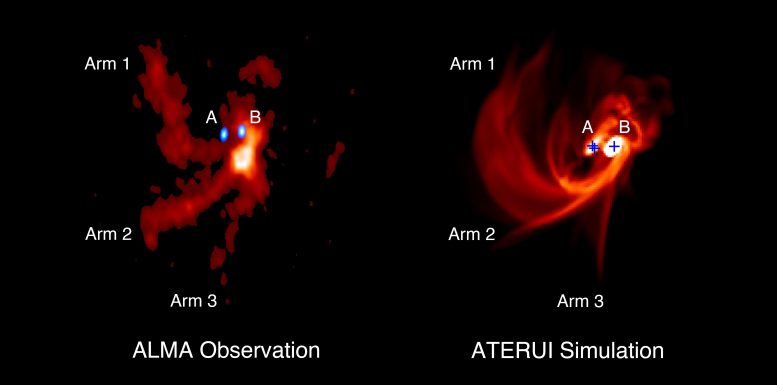
Gas distribution around the trinary protostars IRAS 04239+2436, (left) ALMA observations of SO emissions, and (right) as reproduced by the numerical simulation on the supercomputer ATERUI. In the left panel, protostars A and B, shown in blue, indicate the radio waves from the dust around the protostars. Within protostar A, two unresolved protostars are thought to exist. In the right panel, the locations of the three protostars are shown by the blue crosses. Credit: ALMA (ESO/NAOJ/NRAO), J.-E. Lee et al.
Detailed Observations and Discoveries
The team observed the radio waves emitted by sulfur monoxide (SO) molecules around the young multiple star system IRAS 04239+2436, using ALMA. IRAS 04239+2436 is a “trinary protostar system,” i.e., a system consisting of three protostars, located about 460 light-years away from us. The research team was expecting to detect SO molecules in the area where shock waves are present, and to see violent gas motion around the protostars. As a result of the observations, they detected SO molecules around the triple protostars, and discovered that the distribution of SO molecules forms large spiral arms extending up to 400 astronomical units. Moreover, they successfully obtained the velocity of the gas containing SO molecules, based on the frequency shift of radio waves due to the Doppler effect.
According to the analysis of the gas motion, it was found that the spiral arms traced by SO molecules are indeed streamers flowing towards the triple protostars. “The most profound feature of our ALMA images is the well-delineated large multiple-arm structures detected in the SO emissions,” says Lee, explaining the significance of this discovery. “My first impression was that the structures were dancing together, spinning around the central protostellar system, although, later, we found that the spiral arms are channels of material feeding the baby stars.”
A simulation of multiple star formation by the supercomputer “ATERUI”. The movie shows that multiple protostars are born in a filamentary turbulent gas cloud, and they excite spiral arms and disturb the surrounding gas as they orbit. Credit: Tomoaki Matsumoto, Takaaki Takeda, 4D2U Project, NAOJ
Significance and Comparative Analysis
To further investigate the gas motion, the research team compared the velocity of the gas derived from this observation with that from numerical simulations which reproduce the formation of multiple stars within the natal gas cloud. These simulations were conducted using “ATERUI” and “ATERUI II”,[1] supercomputers dedicated to astronomy in the Center for Computational Astrophysics at the National Astronomical Observatory of Japan (NAOJ). In the simulation, three protostars form in the gas cloud, and the gas disturbed around the triple protostars excites shock waves in the form of spiral arms.
“We found that the spiral arms exhibit gas flows toward the triple protostars; they are streamers supplying gas to the protostars,” says Matsumoto who led the numerical simulations in this research. “The velocity of the gas derived from the simulations and the observations matches well, indicating that the numerical simulation can indeed explain the origin of the streamers.”
Hybrid Scenario for Multiple Star Formation
By comparing the observations with the numerical simulations, the research team investigated how this triple protostar was born. Up until now, two scenarios had been proposed for the formation of multiple stars. The first is the ‘turbulent fragmentation scenario,’ in which the turbulent gas cloud fragments into gas condensations, each of which evolves into a protostar. The second is the ‘disk fragmentation scenario,’ where the gas disk surrounding a protostar fragments to form a new protostar, leading to multiple stars.
The triple protostar observed here can be explained by a hybrid scenario in which the star formation process starts as a turbulent natal gas cloud, similar to the turbulent fragmentation scenario, and then, the seeds of new protostars are produced in the disk, like in the disk fragmentation scenario, and the surrounding gas turbulence causes the spiral arms to extend widely. The observational results are very similar to the simulation results, indicating that the observed triple protostars are the first objects confirmed to demonstrate the formation of multiple stars by a hybrid scenario.
Matsumoto says, “This is the first time that the origin of protostars and the streamers have been simultaneously and comprehensively clarified. The combination of ALMA observations and simulations is a powerful tool for revealing the secrets of star formation.”
Implications for Planet Formation and Future Research
Lee suggests that this study also sheds light on the difficulty of planet formation in multiple star systems. She says, “Planets are born in gas and dust disks that form around protostars. In the case of this triple protostar system, the protostars are located within a small area, the disks around the protostars are small, and orbiting protostars strip the disks from other protostars. Planets form in a calm environment over a long period. Therefore, it is unlikely that IRAS 04239+2436 is a conducive environment for the formation of planets.”
Matsumoto discusses the impact of this study on our understanding of multiple star formation. “The actual observation of a multi-star system in formation through the hybrid scenario will significantly contribute to resolving debates over multiple star formation scenarios. Furthermore, this research didn’t only confirm the existence of the recently noticed streamers but also explained how they formed, marking a significant advancement.”
This research was presented in a paper “Triple spiral arms of a triple protostar system imaged in molecular lines” by Jeong-Eun Lee et al. in the Astrophysical Journal.
Notes
- “ATERUI” and “ATERUI II”: NAOJ’s supercomputers dedicated to numerical simulations in astronomy, operated by CfCA at NAOJ Mizusawa Campus (Oshu City, Iwate Prefecture). ATERUI (Cray XC30) was in operation from 2013 to 2018, with a theoretical peak performance of 1.058 petaflops (1 petaflops represents a performance of one quintillion calculations per second). ATERUI II (Cray XC50) has been in operation since 2018, and its theoretical peak performance of 3.087 petaflops makes it the world’s fastest supercomputer dedicated to astronomy.
Reference: “Triple spiral arms of a triple protostar system imaged in molecular lines” by Jeong-Eun Lee, Tomoaki Matsumoto, Hyun-Jeong Kim, Seokho Lee, Daniel Harsono, Jaehan Bae, Neal J. Evans II, Shu-ichiro Inutsuka, Minho Choi, Ken’ichi Tatematsu, Jae-Joon Lee and Daniel Jaffe, 4 August 2023, The Astrophysical Journal.
DOI: 10.3847/1538-4357/acdd5b
This work is supported by the National Research Foundation (NRF) of Korea grant funded by the Republic of Korea government Ministry of Science and ICT (MSIT) (grant number 2021R1A2C1011718), the Ministry of Education of Taiwan (grant number 110J0353I9), the Ministry of Science and Technology of Taiwan (grant number 111B3005191), and JSPS KAKENHI (grant numbers JP17K0539, JP18H05437, JP20H05645, JP23K03464).

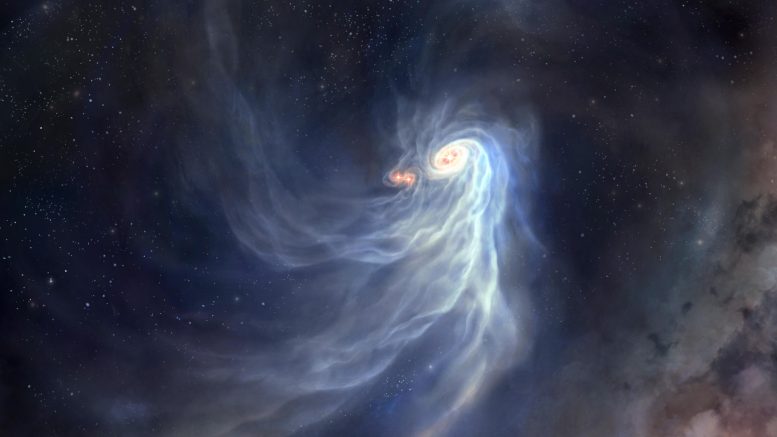
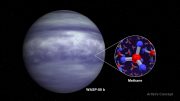

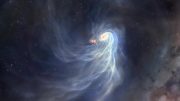



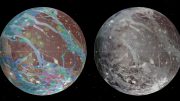

Unseen are the twin streamers of dark matter condensing and circulating into the protostars.